The Golden Circle is Iceland’s most-popular attraction with loads of organised tours taking visitors to all the major sights. However if you hire a car, you can drive the Golden Circle yourself. This is what we did and found it a much better alternative to the organised tours. Here’s what we got up to driving the Golden Circle…
The beauty of visiting Iceland is that many of the stunning natural features that it’s famous for are all clustered together in one region close to the capital Reykjavik – known as the ‘Golden Circle’.
This is a circular road route that runs out from Reykjavik in to the Icelandic countryside, taking in spectacular waterfalls, volcanic craters, geysers, national parks, geothermal lagoons, tectonic plate rift valleys and more – all on a route that’s driveable within one day.
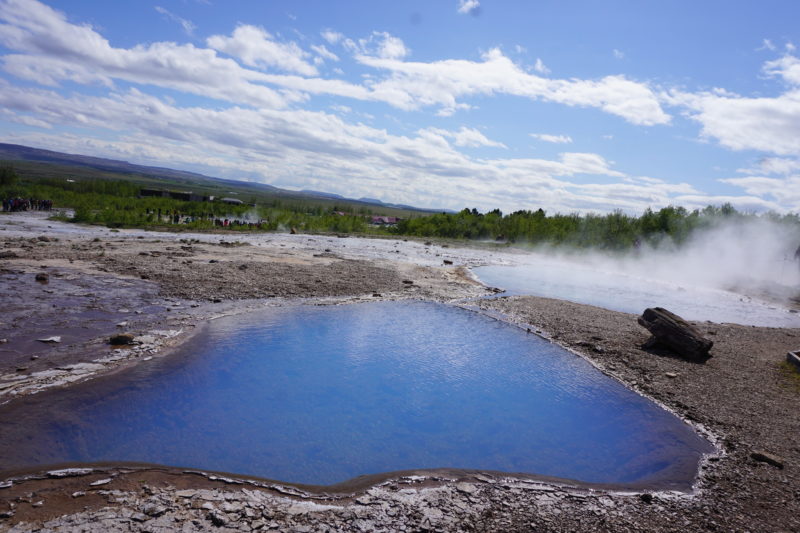
There are many tour operators running Golden Circle excursions by coach or minibus, leaving daily from Reykjavik centre, virtually all of them taking travellers to Thingvellir National Park, Gullfoss Falls and the ‘Geothermal Area’ and Strokker Geyser.
We had a hire car, which makes touring the Golden Circle a much more enjoyable experience in our opinion. This way you can drive the Golden Circle at your own pace staying as long as you like at each attraction and, better still, visit some of the lesser-known sights on the Golden Circle that the tour buses don’t stop at.
We did all this in a day – starting out at about 10am and making good use of the fact that, in the summer, it doesn’t get dark in Iceland so you get as many daylight hours as you need to extend your drive round the Golden Circle and enjoy the incredible sights.
Here’s what we got up to on our own personal Golden Circle drive tour…
Jump to..
- Porufoss Falls
- Thingvellir National Park
- Oxararfoss Falls
- Geyser Geothermal Area / Strokkur Geyser
- Gullfoss Waterfall
- The Secret Lagoon
- Kerid Crater
Porufoss (Þórufoss) Falls
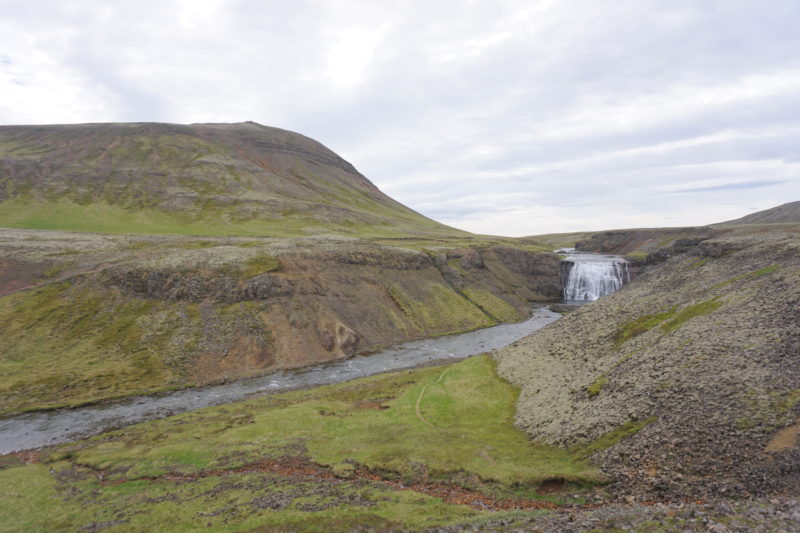
Our first stop driving the Golden Circle was actually a detour from the main route straight away. About 30-minutes in to the journey, we turned off the main road to Porufoss Falls – a 62ft high waterfall and river in the middle of a remote wilderness.
Following Google Maps directions to the falls, we were convinced they were wrong as our destination was reached in a flat and inconspicuous lay-by by the side of a quiet road. No sign of a waterfall anywhere to be seen.
However a short walk across the grass revealed this magnificent, isolated waterfall amongst dramatic surroundings without another tourist anywhere in sight.
We clambered down a rocky path to get closer and take some photos by the falls, the kids inspecting all the chunks of lava scattered around the river bed.
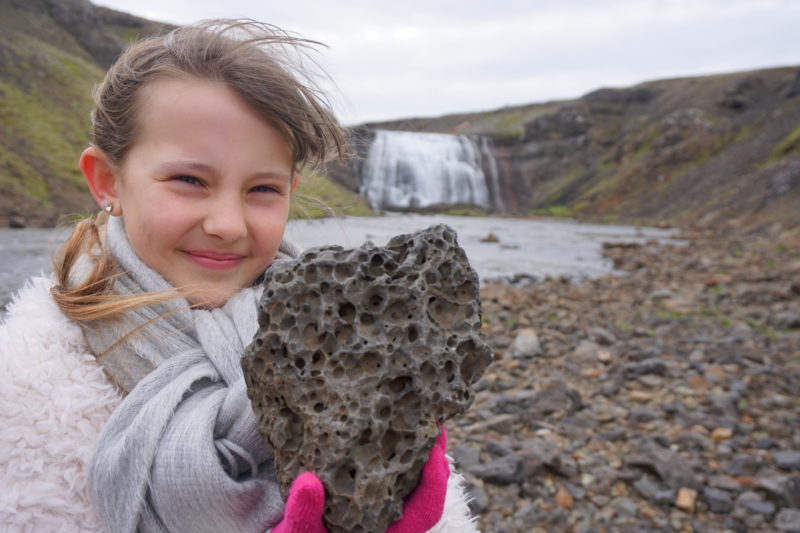
There’s not a huge amount to see here, so once we’d spent 15-minutes or so climbing around to different viewpoints, we climbed back up to the car and carried on our way back to the main Golden Circle route. Definitely a worthwhile first stop on the tour though.
Thingvellir National Park
The first main attraction on the route, where all the coach tours head, is Thingvellir (Þingvellir) National Park.
This is a large natural park with a huge lake, waterfalls and geological features formed at the point where the North Atlantic and Eurasian tectonic plates meet.
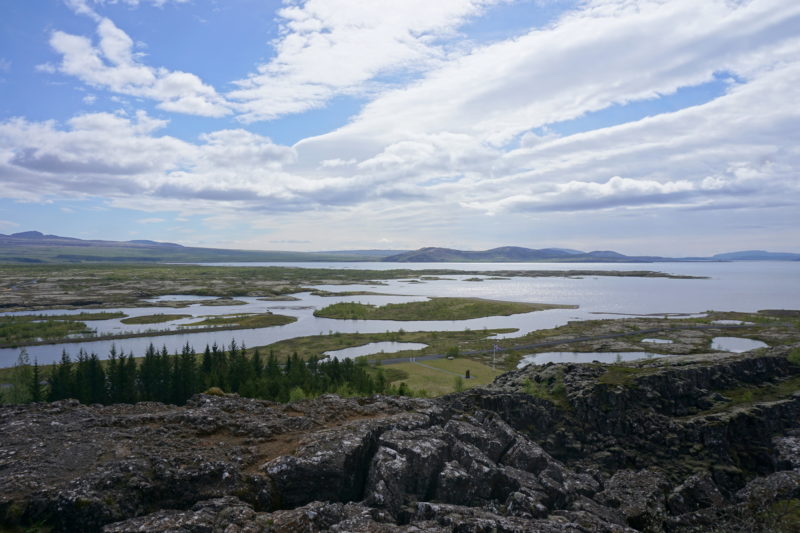
You’re literally stood on and between the fault-line that’s responsible for all of Iceland’s volcanic activity – and it’s created a really beautiful landscape.
Aside from looking at the views across the lake and ‘rift valley’, we didn’t find a huge amount to do here, mainly because the kids weren’t up for doing a big hike around the park’s trails (neither were we!)
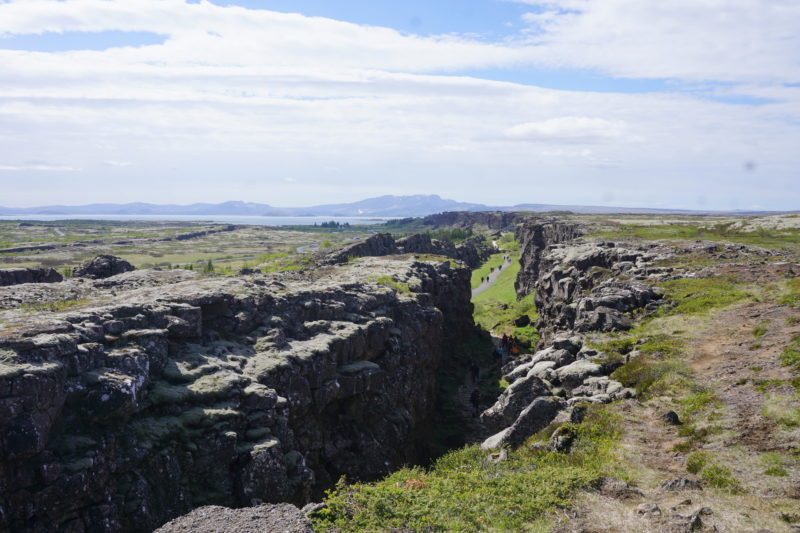
If you’re driving here, you get immediately stung for a full day’s parking charge by number plate recognition cameras that capture you on the way in and ensure you can’t get back out without paying the full day parking fee (which wasn’t actually that much). Slightly annoying as we only spent 15-minutes or so here looking at the view!
For us, a better feature of Thingvellir is about 5-minutes further along the road from the main National Park entrance: Oxararfoss Falls…
- Google Maps destination for Thingvellir National Park main car park (beware the automatic parking charge as you enter here).
Oxararfoss Falls
There’s a car park at the head of a short walk that takes you through a ravine, which is picturesque enough in its own right. It was used in a scene from Game of Thrones which you might recognise from the image below (the big gate doesn’t exist in real life, it’s a CGI addition!)
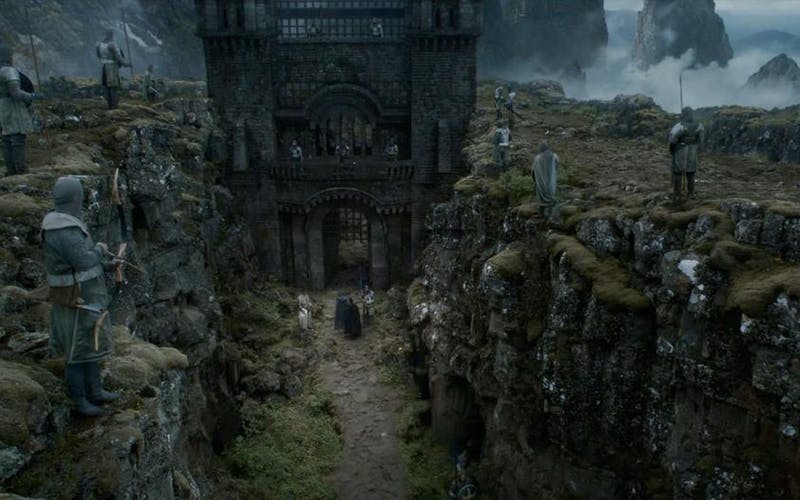
Follow the path along for about 10-minutes and you reach the beautiful Oxararfoss waterfall. There’s a wooden viewing platform and seating areas ideal for relaxing and taking photos.
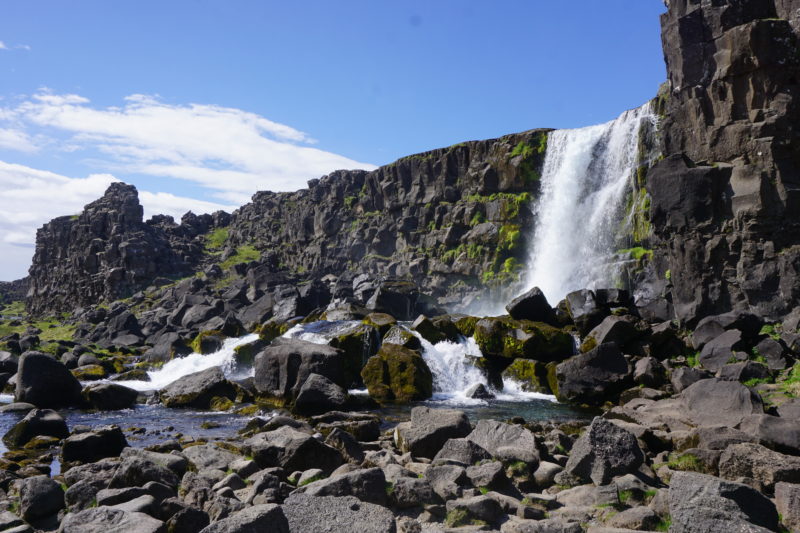
On the bright, sunny late May day we were here it was spectacular, the water glistening in the bright sun and the colours of the moss on the black rocks standing out with the blue sky above.
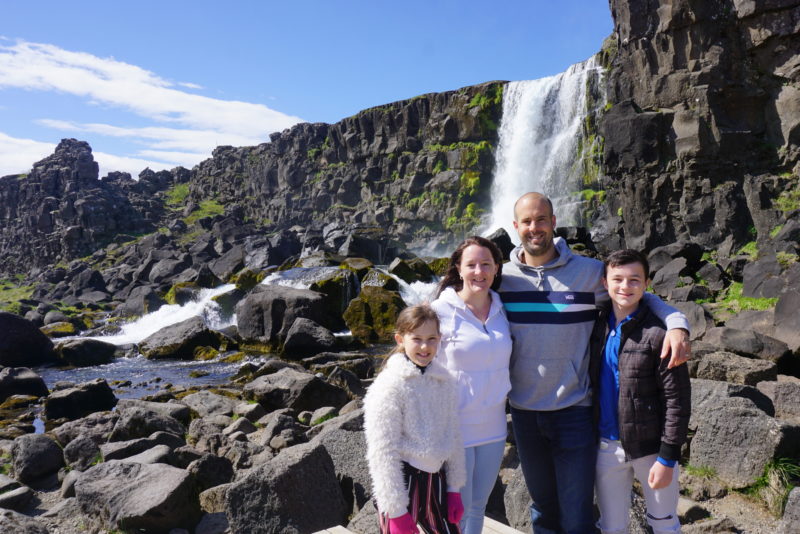
We brought a packed lunch and sat here eating it, enjoying the views before heading back to the car and on to our next destination on the Golden Circle route…
Geyser Geothermal Area and Strokkur Geyser
The longest bit of driving of the day was out to the geothermal field – but driving the Golden Circle route is no hardship at all. Long, straight and empty roads stretch ahead of you through dramatic, barren and sometimes bizarre landscapes more reminiscent of driving on another planet in places!
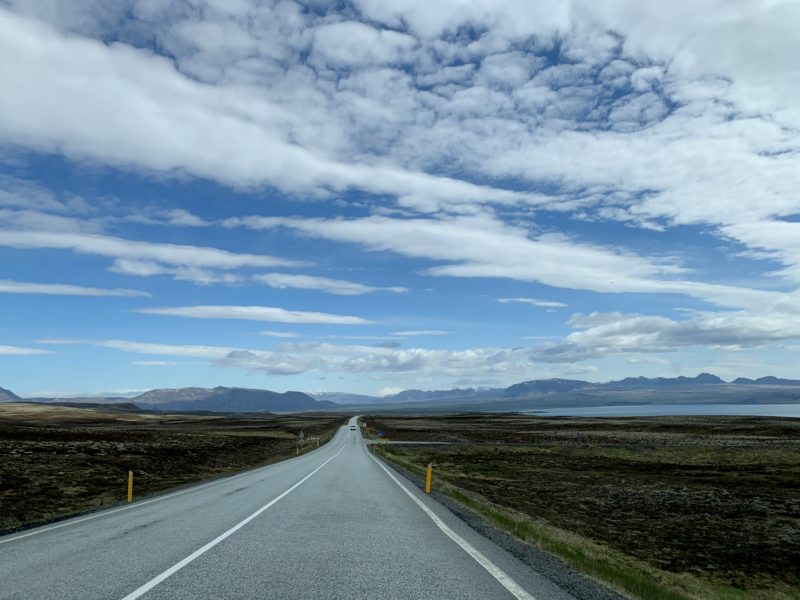
Our destination was a large car park next to the ‘Hotel Restaurant Geyser’. This was our favourite stop-off of the day – the Strokkur Geyser being a dramatic and exciting sight, the likes of which can only be viewed in very few places on earth.
Walking from the car park, across the main road, a path leads past several small, steaming hot spring pools and mini geysers before arriving at the main attraction – the big Strokkur Geyser.

You’re met by the sight of a ring of tourists stood quietly, staring, cameras pointing expectantly at a large, still pool of steaming water on the ground.
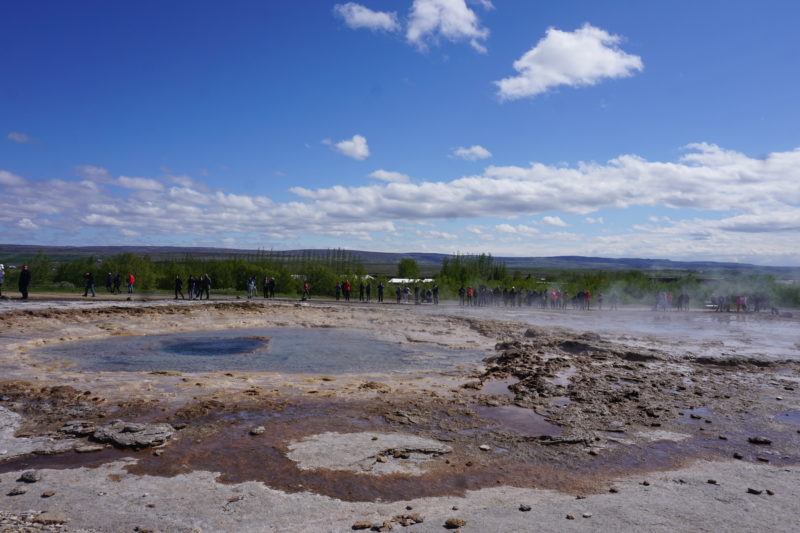
We joined them on the side of the circle that was empty of other visitors and stood watching, wondering how long you had to wait to see any action from the geyser.
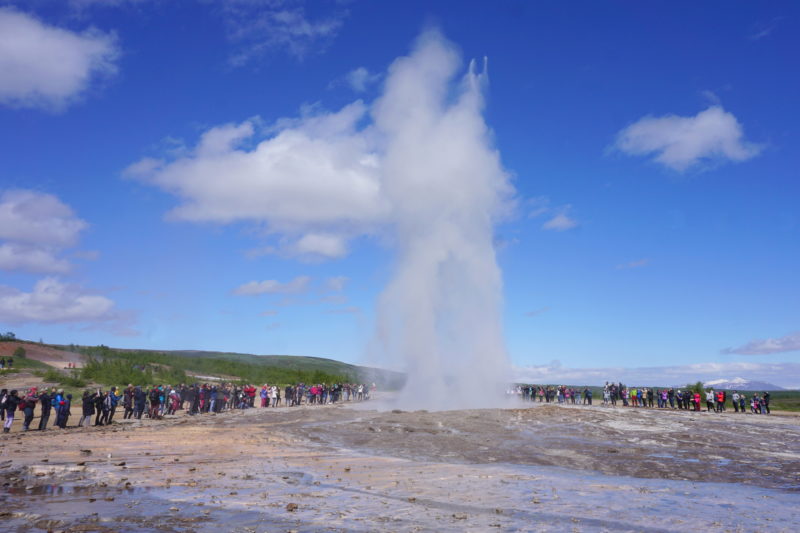
The answer came pretty quickly, as out of nowhere the geyser exploded in to life, shooting a mass of steaming hot water high in to the blue sky above us.
We realised why this side of the geyser was otherwise devoid of other tourists as it was down-wind, meaning the entire contents that had been blown in to the air was dumped down on our heads!
That was a fun start, but we headed round to the other side and stood again, waiting for the next eruption, which came after another 5 minutes or so.
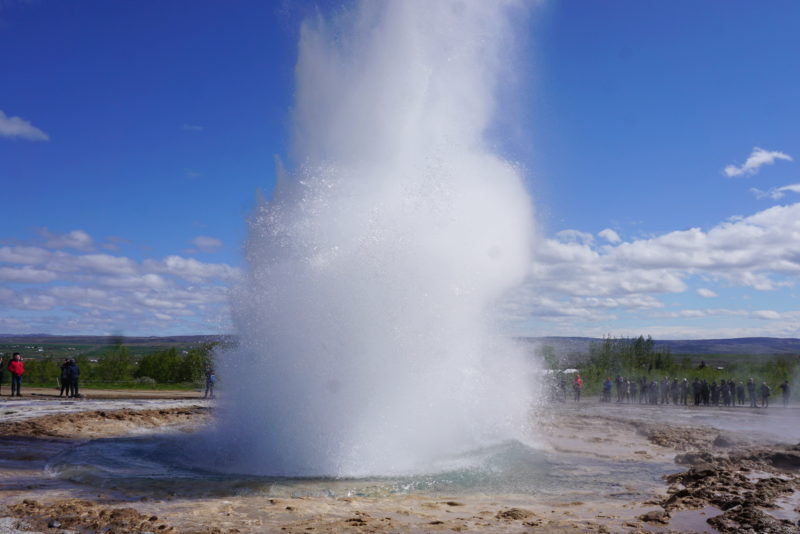
It seems the geyser erupts typically between every 5 and 10 minutes. Sometimes small eruptions came in quicker intervals, sometimes there were longer waits as it seemed the water pressure built up more and the resulting explosion of water was higher and more dramatic.
Everyone stands around with their cameras poised, waiting for the moment of the next eruption so they can snap shots of this rare sight. We spent plenty of time photographing, selfie-ing and videoing the geyser, but it’s important to remember to take time to put the camera down and watch this spectacle with your own eyes too.
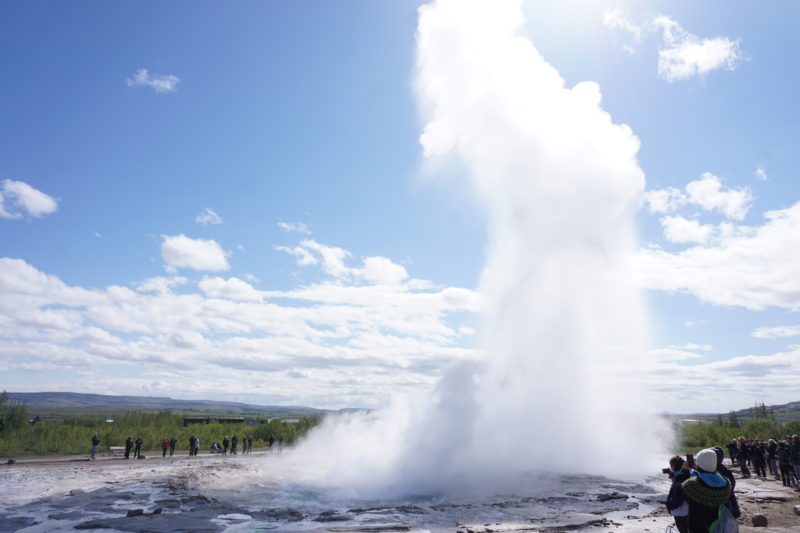
The bursts of water last only a second or two and you really need to experience and see them ‘in real life’ rather than only through a camera lens.
There is another geyser right next to the very active Strokkur called the ‘Great Geyser’, which is a much bigger one that previously shot water 100-metres in to the air. However it’s now dormant, having not erupted for decades.
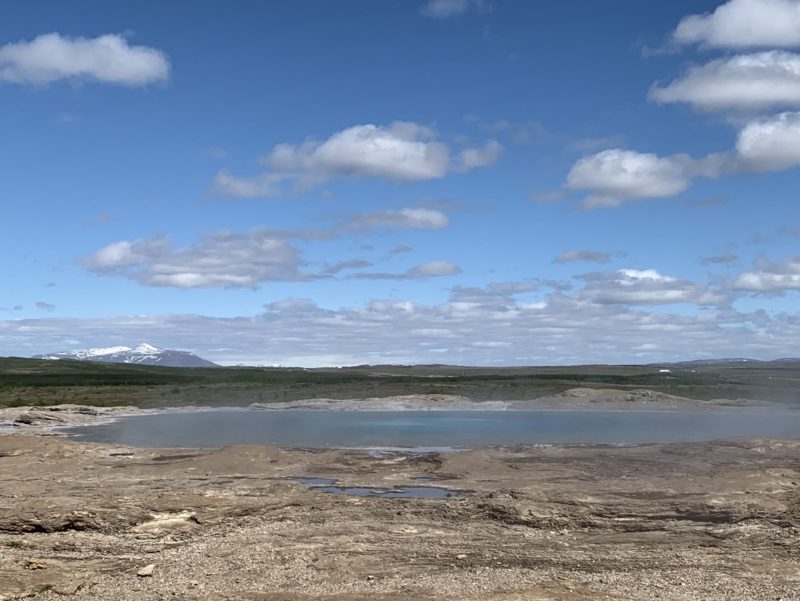
There are paths leading away from the geyser that you can follow up the hillsides to view it from a long distance, but the main attraction is to be stood right next to the geyser as it goes off.
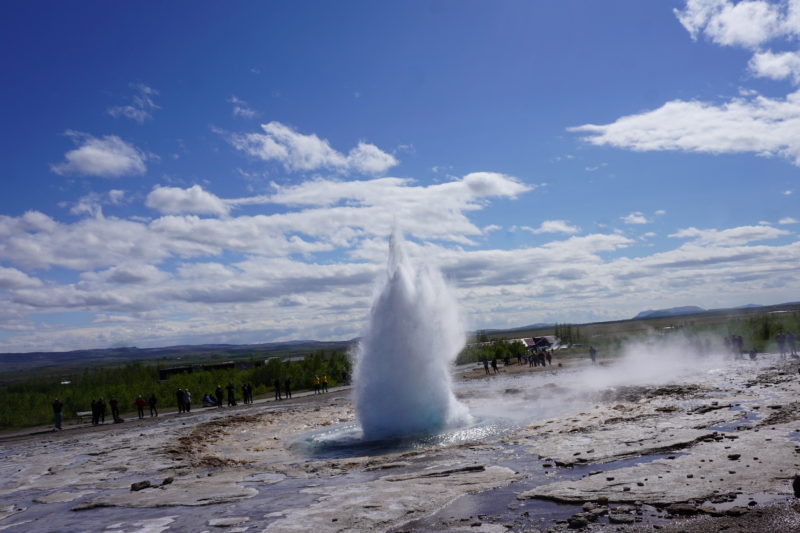
Watching it never seemed to get boring – it was interesting every single time it went off and we could’ve spent a long time here, but time was getting on and we had more stops to visit on the Golden Circle.
Gullfoss Falls
Having seen the serene Oxararfoss waterfall earlier in the day, we were expecting much the same from this stop on the circle – Gullfoss Falls.
But Gullfoss is very different – a massive, thundering waterfall that spans a wide river and plunges dramatically through a huge canyon.
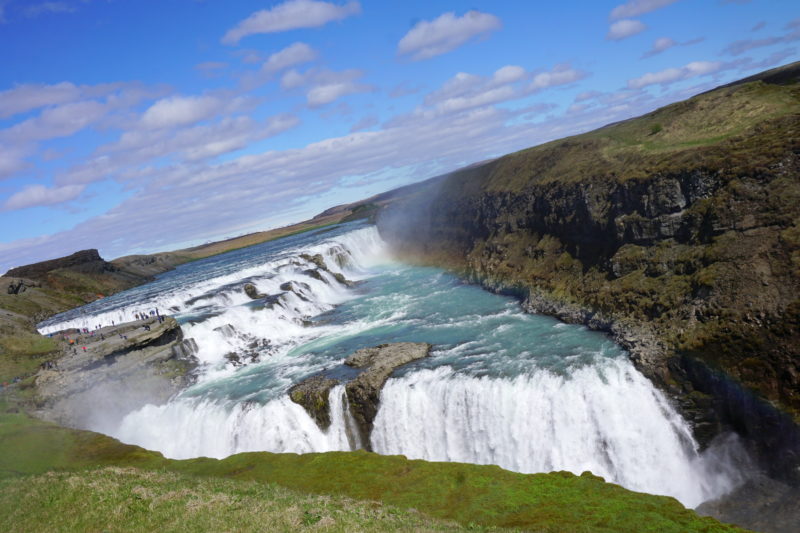
Our daughter Emma summed it up as the falls came in to sight: “Whoa! It’s the biggest waterfall I’ve ever seen; like one of those on a film!”
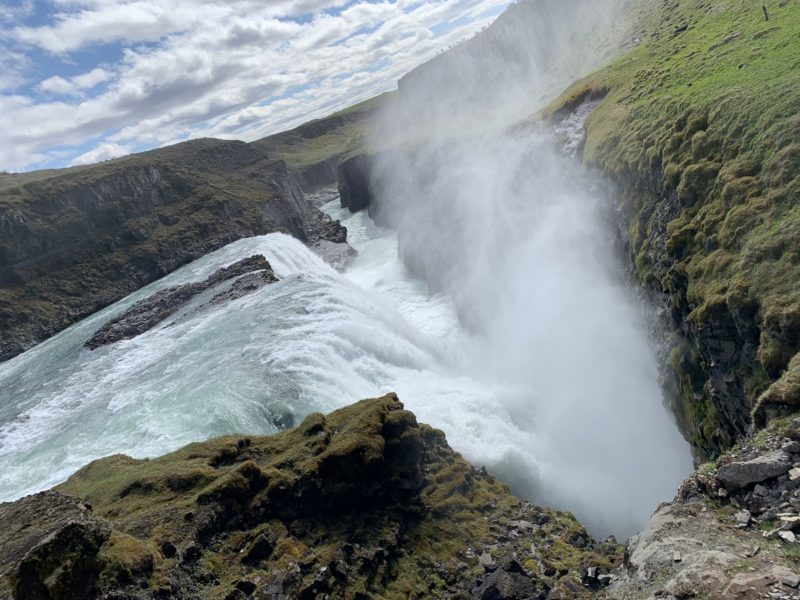
We’ve been to many waterfalls on our travels but never one as large as Gullfoss. This feels like a ‘real’ waterfall – one where the roar of the water makes it hard to hear anyone speak and spray covers you even on the footpath on the way down to the edge. On a sunny day like on our visit, rainbows appear all around you.
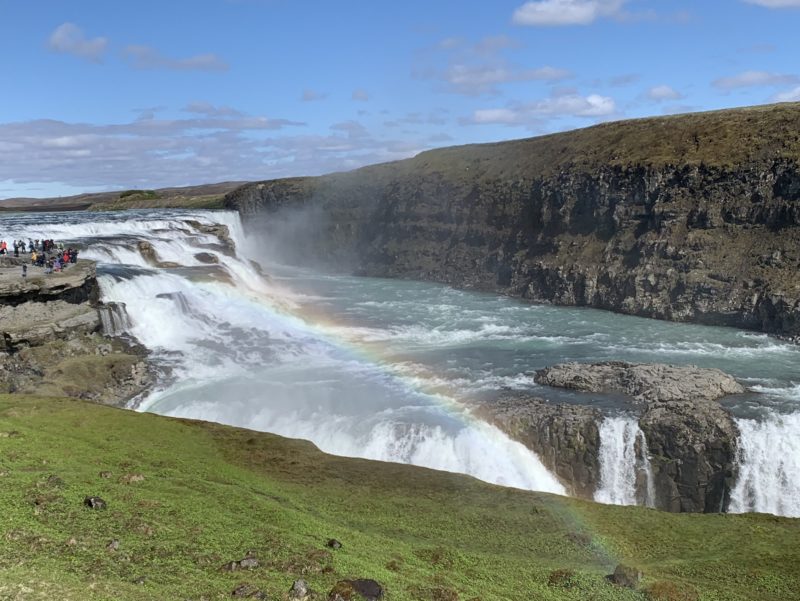
There’s a big car park by the falls with a well-made footpath that leads to a viewing platform right at the edge of the waterfall. We were obviously here in summer and a friend of ours sent us a photo from exactly the same spot when he’d been a few months ago and it was a totally different picture – most of the cascading water frozen solid!
Gullfoss waterfall is certainly an impressive stop when driving the Golden Circle route and one absolutely not to be missed!
Google Maps destination for Gullfoss Falls
The Secret Lagoon
Our next destination was The Secret Lagoon, about 45-minutes drive from the geyser area.
This is an area on a farm filled with boiling hot springs and mini geysers, which the landowners have channeled in to a large swimming pool full of this hot spring water.
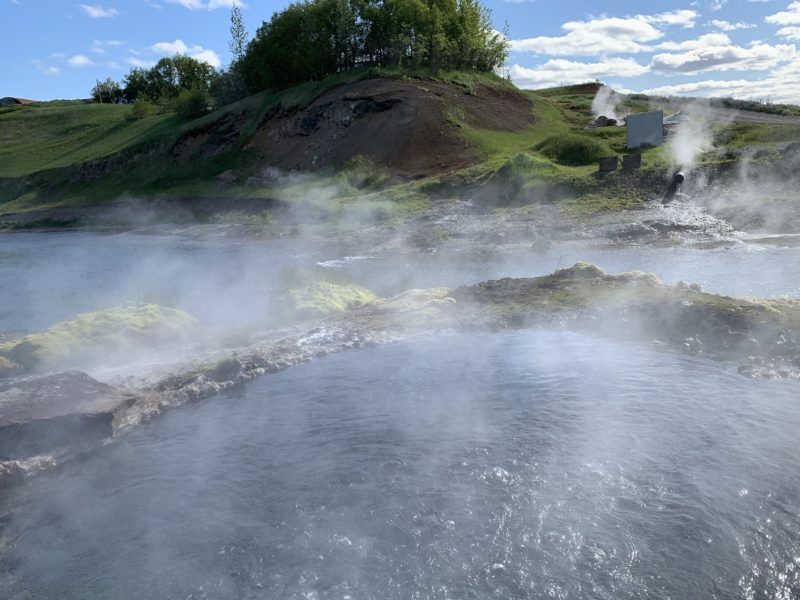
There’s nothing secret about it – it’s a popular destination, although doesn’t seem to be a regular stop for the organised tour buses and wasn’t overly busy when we arrived late afternoon.
This is a well-placed attraction to take some time out on the Golden Circle tour and relax after the day’s travelling and sight-seeing.
It’s a paid attraction – and they provide towels and the option to hire swimming costumes if you don’t happen to have brought those with you.
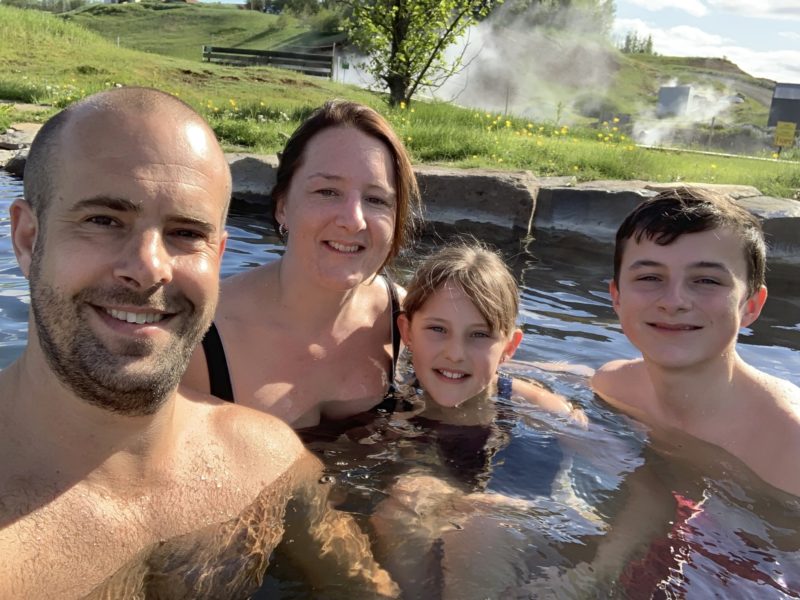
Changing rooms and showers lead through to the open air pool, which is a large rectangular pool dug out from the ground right next to the hot springs.
You can’t get in the hot springs themselves because they are literally boiling – bubbling, steaming water at 100-degrees.
The pool water itself is very pleasantly warm. In some spots it’s really hot. It’s a relaxing and welcoming experience to go from the cold Icelandic wind in your swimming stuff, plunging in to this giant natural hot-tub where you can float around and relax in the incredible surroundings.
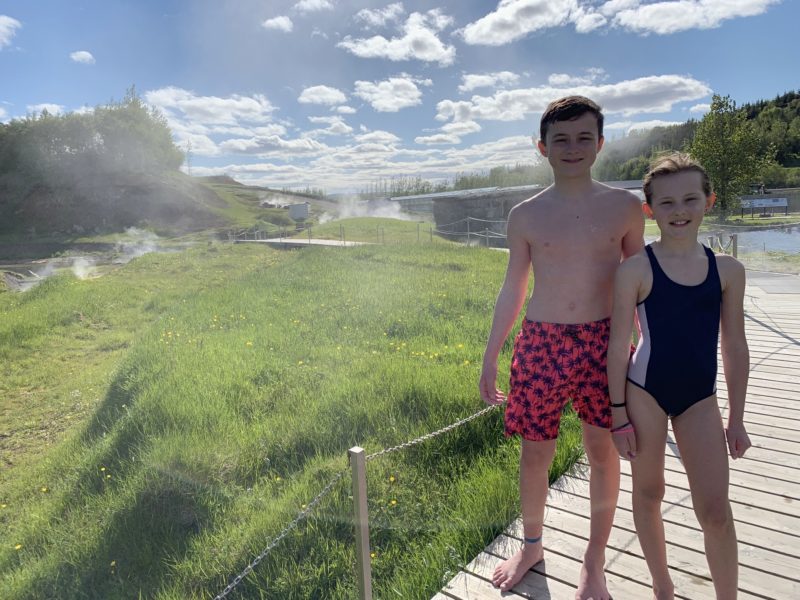
There’s a walkway built around the grounds which you can follow whenever you need to get out and cool down, looking in to the hot springs and mini geysers that feed the secret lagoon’s pool.
The Secret Lagoon is a very different experience to the more famous Blue Lagoon. It’s much smaller and the water is clear, without the mysterious milky blue colouring of the Blue Lagoon.
A visit to the Secret Lagoon is a much more low key (and lower cost) experience than the Blue Lagoon and, while they are both public pools full of naturally-heated geothermal spring water, the Secret Lagoon isn’t a substitute for also visiting the Blue Lagoon.
It is however a very welcome and enjoyable detour from the Golden Circle route and well worth visiting.
There’s a fish and chips stall here, so we bought ourselves some dinner, which was delicious but very pricey by UK standards. £50 for a small fish & chips for all four of us! Iceland is an extremely expensive place to visit and everything, when converted in to UK prices, is eye-wateringly expensive.
Kerid Crater
The car journey from the Secret Lagoon back to Reykjavik was longer than we expected – about an hour and a half – so we looked for another stop-off point to break up the journey.
We decided on the Kerid (Kerið) Crater – a volcanic crater in the middle of the countryside with a lake and a path around the rim from which you can walk around and down in to the crater itself.
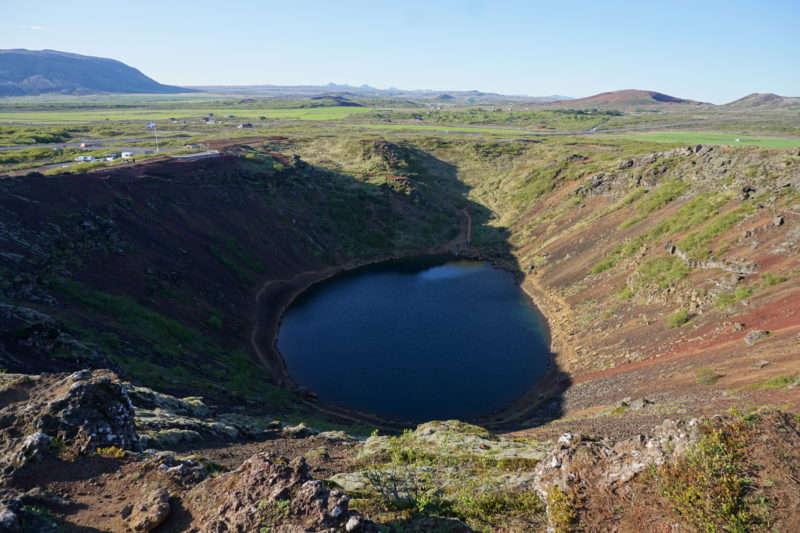
Kerid Crater is on private land so there is an entry fee, although it was only a few quid, so we decided it was worth checking out.
We felt it was a good way of breaking up the journey – but not really a particularly interesting destination in its own right.
Ten or fifteen minutes walking the path around the crater, snapping a few photos, and the visit is done.
It was an impressive sight in the early evening sun and a good photo opportunity, but not something – in comparison with the other sights on the Golden Circle you’ll have already seen – that you’ll remember for years to come.
From the Kerid Crater, we headed back to our apartment in Reykjavik, arriving back at about 10pm, 12-hours after setting out (and still in broad daylight in the summer months).
If you’re visiting Iceland, the Golden Circle route is essential. It’s hard to imagine any visitor coming to the country and not doing it – as so many of the main attractions and unique natural phenomena of the country are here.
If you’re able to, we’d highly recommend doing it by car rather than tour bus. Driving the Golden Circle is so easy with its long, straight, clear roads and the ability to go at your own pace, detouring to other sights as and when you want to, make it a much more enjoyable experience.

Thank you for posting this log. Enjoyable and very helpful as I am planning a self – organised trip to Rekjavik this September.